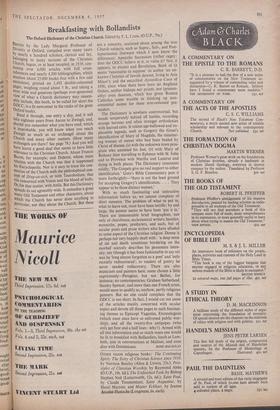Breakfasting with Bollandists
The Oxford Dictionary of the Christian Church. Edited by F. L. Cross. (O.U.P., 70s.) E_orr. ED by the Lady Margaret Professor of by at Oxford, compiled over many years belonging nearly a hundred scholars, clerical and lay, Church, to many sections of the Christian h. urch, begun, or at least incepted, in 1939, con- taining over 6,000 articles with full cross- references and nearly 4,500 bibliographies, which mention about 25,000 books (but with a few odd omissions), printed on 1,492 double-columned pages, weighing round about 5 lb., and taking a most wide and generous (perhaps over-generous) view of what a Church dictionary may reason- ably include, this book, to be called for short the ODCC, is a fit newcomer to the ranks of the great Oxford books.
Read it through, one entry a day, and it will take eighteen years from Aaron to Zwingli, and, should you remember what you have read, which Is improbable, you will know when you reach Zwingli as much as an archangel about the Church and many other matters. (How many archangels are there? See page 78.) And you will have learnt a good deal that seems to have little relevance to the Christian Church. About Francis bacon, for example; and Diderot, whose main relation with the Church was that it suppressed his Encyclopedia. Nor is it easy to trace the con- nection of the Church with the philoSophical con- cept of Ding-an-sick, or with Taurobolium, that rite concerned with Venus and the blood of bulls. Or, for that matter, with Attila. But this Dictionary spreads its net agreeably wide. It enmeshes a great
many Old Testament and other characters, i about
Which the Church has never done anything in Particular, nor they about the Church. But these
are a minority, scattered about among the true Church subjects, such as Supra-, Sub-, and Post- lapsarianism (between which I now know the difference); Apostolic Succession (rather cagey : does the ODCC believe in it. or value it? Not, it appears, to excess) and Revelation, Book of (it seems 'reasonable to suppose' its author an un- known Christian of Jewish descent, living in Asia Minor'); and the encyclical A postolicce Claw of 1896, since when there have been no Anglican Orders, neither bishops nor priests, nor (presum- ably) even deacons, which has given Roman Catholics some trouble in thinkingup non- committal names for these non-ordained pre- tenders. The Dictionary is nowhere controversial, but stands temperately behind all battles, recording strange heresies and often stranger orthodoxies with learned calm. It relates age-hallowed and im- plausible legends, such as Gregory the Great's identification of Mary of Magdala, the minister- ing woman of means who had been healed by Christ of disease, (a) with the unknown town pros- titute who anointed his feet, (h) with Mary of Bethany later travelling to Ephesus with St. John and to Provence with Martha and Lazarus and dying in both places. The Dictionary comments mildly, 'The Gospels give no real support to either identification.' Gore's Bible Commentary puts it more forthrightly—`there is not the least ground for accepting Gregory's identification. . . . They appear to be three distinct women.'
With so much fascinating and instructive information before us, we cannot complain of short measure. The problem of what to put in, what to leave out, must have been terrific; by and large, the answer seems to have been 'put it in.' There are innumerable brief biographies, not only of churchmen, ecclesiastical writers, heretics, monarchs, popes, presbyters, and such, but of secular poets and prose writers who have alluded to some aspect of the Christian religion. Donne is perhaps not very happily dealt with : 'a deep sense of sin and death sometimes bordering on the morbid' scarcely describes his passionate inten- sity; nor (though it has been fashionable to say so) was he 'long almost forgotten as a poet' and 'only recently rediscovered'; to readers of poetry he never needed rediscovery. There are also musicians and painters here; some chosen a little capriciously—Perugino, but not Bellini, for instance; no contemporaries; Graham Sutherland, Stanley Spencer, and more than one French artist, would seem to qualify as, anyhow, partly religious painters. But no one could complain that the ODCC is too short. In fact, I would cut out some of the articles mainly concerned with secular topics and devote all these pages to such fascinat- ing themes as Episcopi Vagantes, Exomologesis (which must once have so enlivened public wor- ship), and all the twenty-five antipopes (who only get four and a half lines : why?). Armed with all this information and so much more one would be fit to breakfast with Bollandists, lunch at Lam- beth, join in conversations at Malines, and even














































 Previous page
Previous page